![]()
![]()
![]()
Use LEFT and RIGHT arrow keys to navigate between flashcards;
Use UP and DOWN arrow keys to flip the card;
H to show hint;
A reads text to speech;
55 Cards in this Set
- Front
- Back
|
Whattype of immunity results from vaccination?A)innate immunity B)naturally acquired active immunity C)naturally acquired passive immunity D)artificially acquired active immunity E)artificially acquired passive immunity |
D) artificially acquired active immunity |
|
|
Whattype of immunity results from transfer of antibodies from one individual to asusceptible individual by means of injection? A)innate immunity B)naturally acquired active immunity C)naturally acquired passive immunity D)artificially acquired active immunity E)artificially acquired passive immunity |
E) artificially acquired passive immunity |
|
|
Whattype of immunity results from recovery from mumps?A)innate immunity B)naturally acquired active immunity C)naturally acquired passive immunity D)artificially acquired active immunity E)artificially acquired passive immunity |
B) naturally acquired active immunity |
|
|
Whichof the following is the best definition of epitope? A)specific regions on antigens that interact with T-cell receptors B)specific regions on antigens that interact with MHC class molecules C)specific regions on antigens that interact with haptens D)specific regions on antigens that interact with antibodies E)specific regions on antigens that interact with perforins |
D) specific regions on antigens that interact with antibodies |
|
|
Newborns'immunity due to the transfer of antibodies across the placenta is an example ofA)innate immunity. B)naturally acquired active immunity. C)naturally acquired passive immunity. D)artificially acquired active immunity. E)artificially acquired passive immunity. |
C) naturally acquired passive immunity. |
|
|
Whichof the following statements is NOT a possible outcome of antigen-antibodyreaction?A)clonal deletion B)activation of complement C)opsonization D)ADCC E)agglutination |
A) clonal deletion |
|
|
Whichof the following cells is NOT an APC? A)dentritic cells B)macrophages C)immature B cells D)natural killer cells E)None of the answers is correct; all of these are APCs. |
D) natural killer cells |
|
|
Whenan antibody binds to a toxin, the resulting action is referred to as A)agglutination. B)opsonization. C)ADCC. D)apoptosis. E)neutralization. |
E) neutralization. |
|
|
CD4+ T cells are activated by A)interaction between CD4+ and MHC II. B)interaction between TCRs and MHC II. C)cytokines released by dendritic cells. D)cytokines released by B cells. E)complement. |
A) interaction between CD4+ and MHC II. |
|
|
Whichof the following recognizes antigens displayed on host cells with MHC II? A)TC cell B)B cell C)TH cell D)natural killer cell E)basophil |
C) TH cell |
|
|
Thespecificity of an antibody is due to A)its valence. B)the H chains. C)the L chains. D)the constant portions of the H and L chains.E)the variable portions of the H and L chains. |
E) the variable portions of the H and L chains. |
|
|
Whichof the following is NOT a characteristic of B cells? A)They originate in bone marrow. B)They have antibodies on their surfaces. C)They are responsible for the memory response. D)They are responsible for antibody formation.E)They recognize antigens associated with MHC I. |
E) They recognize antigens associated with MHC I. |
|
|
Whichof the following is NOT a characteristic of cellular immunity? A)The cells originate in bone marrow. B)Cells are processed in the thymus gland. C)It can inhibit the immune response. D)B cells make antibodies. E)T cells react with antigens. |
D) B cells make antibodies. |
|
|
Plasmacells are activated by a(n) A)antigen. B)T cell. C)B cell. D)memory cell. E)APC. |
A) antigen. |
|
|
Theantibodies found in mucus, saliva, and tears are A)IgG. B)IgM. C)IgA. D)IgD. E)IgE. |
C) IgA. |
|
|
Theantibodies found on the surface of B cells, and which always exist as monomers,are A)IgG. B)IgM. C)IgA. D)IgD. E)IgE. |
D) IgD. |
|
|
Theantibodies that can bind to large parasites are A)IgG. B)IgM. C)IgA. D)IgD. E)IgE. |
E) IgE. |
|
|
Inaddition to IgG, the antibodies that can fix complement are A)IgM. B)IgA. C)IgD. D)IgE. E)None of the answers is correct. |
A) IgM. |
|
|
Largeantibodies that agglutinate antigens are A)IgG. B)IgM. C)IgA. D)IgD. E)IgE. |
B) IgM. |
|
|
Themost abundant class of antibodies in serum is A)IgG. B)IgM. C)IgA. D)IgD. E)IgE. |
A) IgG. |
|
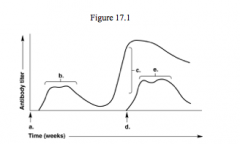
InFigure 17.1, which letter on the graph indicates the patient's secondaryresponse to an antigen? A)a B)b C)c D)d E)e |
C) c |
|
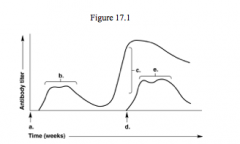
InFigure 17.1, which letter on the graph indicates the highest antibody titerduring the patient’s response to a second antigen? A)a B)b C)c D)d E)e |
E) e |
|
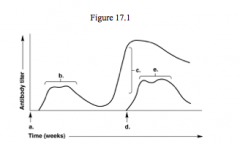
InFigure 17.1, the arrow at time (c) indicates A)the time of exposure to the same antigen as at time (a). B)the secondary response. C)the primary response. D)exposure to a new antigen. E) the T-cell response. |
B) the secondary response. |
|
|
Whichof the following statements is FALSE? A)The variable region of a heavy chain binds with antigen. B)The variable region of a light chain binds with antigen. C)The Fc region attaches to a host cell. D)The constant region of a heavy chain is the same for all antibodies. E) All of the answers are correct |
D) The constant region of a heavy chain is the same for all antibodies. |
|
|
Whichof the following is the best definition of antigen? A)something foreign in the body B)a chemical that elicits an antibody response and can combine with theseantibodies C)a chemical that combines with antibodies D)a pathogen E)a protein that combines with antibodies |
B) a chemical that elicits an antibody response and can combine with these antibodies |
|
|
Whichof the following WBCs are NOT lymphocytes? A)cytotoxic T cells B)helper T cells C)NK cells D)M cells E)B cells |
D) M cells |
|
|
Thefollowing events elicit an antibody response. What is the third step? A)Antigen-digest goes to surface of APC. B)APC phagocytizes antigen. C)B cell is activated. D)TH cell recognizes antigen-digest and MHC II.E)TH cell produces cytokines. |
D) TH cell recognizes antigen-digest and MHC II. |
|
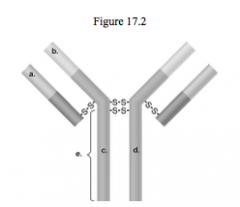
InFigure 17.2, which areas are similar for all IgG antibodies? A)a and b B)a and c C)b and c D)c and d E)b and d |
D) c and d |
|

InFigure 17.2, which areas are different for all IgM antibodies? A)a and b B)a and c C)b and c D)c and d |
A) a and b |
|
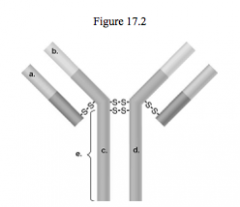
InFigure 17.2, which areas represent antigen-binding sites? A)a and b B)a and c C)b and c D)c and d E)b and d |
A) a and b |
|
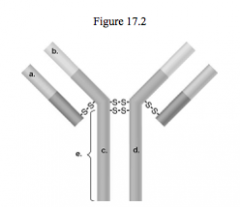
In Figure 17.2, whatcan attach to a host cell? A)a and c B)b and c C)b D)a and d E)e |
E) e |
|
|
Whichof the following bacterial components would most likely result in B cellstimulation by T-independent antigens? A)capsule B)flagellum C)pili D)ribosome E)plasmid |
A) capsule |
|
|
Thepresence of which of the following indicates a current infection rather than aprevious infection or vaccination? A)IgA B)IgG C)IgM D)IgD E)IgE |
C) IgM |
|
|
Whichof the following destroys virus-infected cells? A)CTL B)Treg C)TH D)dendritic cells E)B cells |
A) CTL |
|
|
Thefollowing events occur in cellular immunity. What is the third step? A)Antibodies are produced. B)Dendritic cell takes up antigen. C)Antigen enters M cell. D)TH cell produces cytokines. E)TH cells proliferate. |
E) TH cells proliferate. |
|
|
Cytokinesreleased by TH1cells A)activate CD8+ cells to CTLs. B)convert TH1cells to TH2cells. C)convert TH2cells to TH1cells. D)kill parasites. E)convert B cells to T cells. |
A) activate CD8+ cells to CTLs. |
|
|
Whichone of the following causes transmembrane channels in target cells? A)granzymes B)hapten C)IL-1 D)IL-2 E)perforin |
E) perforin |
|
|
Ata minimum, the human immune system is capable of recognizing approximately howmany different antigens? A)105 B)1010 C)1015 D)1020 E)1025 |
C) 1015 |
|
|
Thymicselection A)destroys T cells that do not recognize self-molecules of MHC. B)destroys B cells that make antibodies against self. C)destroys MHC molecules. D)destroys CD4+ cells that attack self. E)activates B cells. |
A) destroys T cells that do not recognize self-molecules of MHC. |
|
|
Whichof the following statements about natural killer cells is FALSE? A)They destroy virus-infected cells. B)They destroy tumor cells. C)They destroy cells lacking MHC I. D)They are stimulated by an antigen. E)None of the answers are correct; all of these statements are true. |
D) They are stimulated by an antigen. |
|
|
Anantibody's Fc region can be bound by A)antibodies. B)macrophages. C)T helper cells. D)B cells. E)CTLs. |
B) macrophages. |
|
|
ATreg cell deficiency could result in A)increased number of viral infections. B)increased number of bacterial infections. C)autoimmunity. D)increased severity of bacterial infections. E)transplant rejection. |
C) autoimmunity. |
|
|
ADCCis a process that is most effective in destroying A)eukaryotic pathogens. B)virus-infected host cells. C)extracellular viruses. D)bacterial pathogens. E)bacterial toxins. |
A) eukaryotic pathogens. |
|
|
IL-2,produced by TH cells, A)activates macrophages. B)stimulates TH cell maturation. C)causes phagocytosis. D)activates antigen-presenting cells. E)activates TC cells to CTLs. |
B) stimulates TH cell maturation. |
|
|
Whichof the following statements about IL-12 is FALSE? A)It activates macrophages. B)It inhibits some tumor cells. C)It activates the TH1pathway. D)It causes autoimmune diseases. E)It causes TH cells to respond to HIV. |
E) It causes TH cells to respond to HIV. |
|
|
Apoptosis results in significantleakage of cellular contents. |
False |
|
|
Cytokines areprotein-based chemical messengers that allow for communication between cells ofthe immune system |
True |
|
|
Onlydendritic cells produce interleukins. |
False |
|
|
The production ofinterferons at an infection site is critical for chemotaxis. |
False |
|
|
Cytokine stormsnegatively impact human health. |
True |
|
|
The variable region ofthe antibody is solely responsible the significant diversity of antigentargets. |
False |
|
|
Plasma cells willeventually differentiate into memory cells. |
False |
|
|
Memorycells do not require B cell receptors. |
False |
|
|
Theimplementation of vaccinations occurred prior to experimental support for thegerm theory of disease. |
True |
|
|
Whenhaptens attach to carrier molecules, an epitope forms on hapten which then canbe bound to antibody. |
False |

